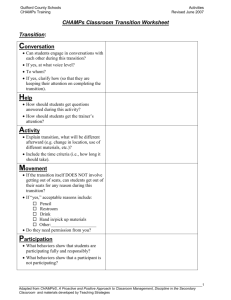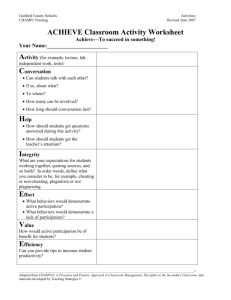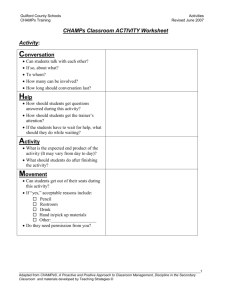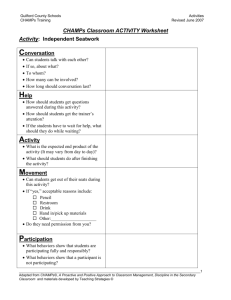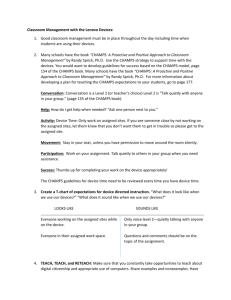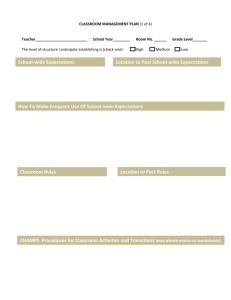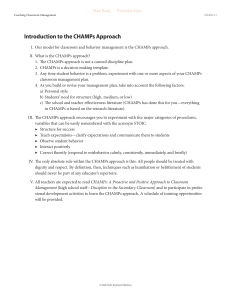CHAMPS: Implementation
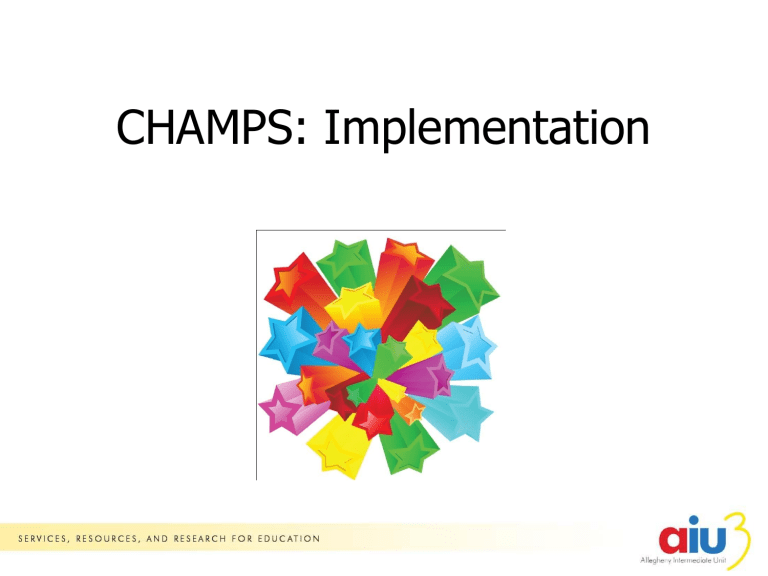
CHAMPS: Implementation
RTII Framework
Tier 3: 1-5%
Tier 2: 5-10%
Tier 1: 80-85%
Universal Prevention
Early Stage Problem Solving
Champs
Behavior
Matrix/Rules
Classroom
Management
3-5 SW Expectations
Olweus
Remember that the multiple tiers of support refer to our SUPPORT not Students.
Computation
Anger
Managemen t
Attendance
Reading
Comprehension
When Structuring the
Classroom
Think about:
– How you like to work
– Level of structure your students need
ASK YOURSELF. . . .WHAT KIND OF STRUCTURE
SHOULD MY CLASSROOM HAVE?
– HIGH
– MEDIUM
– LOW
CHAMPS
• Designed to help you:
– Fine tune or
– Develop a Classroom Management Plan
• Components of the Plan
– Guidelines for Success ( I am GREAT)
– Routines/Procedures (CHAMPS)
– Transitions (CHAMPS)
– Correction procedures
FOCUSES ON POSITIVE, PROACTIVE and INSTRUCTIONAL!
How do we implement
CHAMPS?
Be STOIC
• S tructure your classroom for success.
• Teach students how to be successful in you classroom/school.
• O bserve student behavior.
• I nteract positively.
• C orrect fluently.
• I am GREAT
– Great
– Respectful
– Encouraging
– Act Responsibly
– Think before acting
CHAMPS
Classroom Rules
Hands and feet to self
Use kind words
Have materials ready
Stop, wait, think, act……
CHAMPS
• Conversation – Can students talk to each other?
• Help – How do students get their questions answered? How do they get your attention?
• Activity – What is the task or objective? What is the end product?
• Movement – Can students move about?
• Participation – What does the expected student behavior look like and sound like? How do students show that they are fully participating?
• Success – If students follow the CHAMPS expectations, they will be successful.
FOR ROUTINES AND TRANSITIONS. . . .
Teach Expectations
• T Chart
Guidelines for Success
Rules in Unique Settings
Classrooms
Bathrooms
Hallways
Looks Like Sounds Like
Observe CHAMPS in action. . .
• SCAN and MOVE
• Use data to monitor and evaluate your current classroom management plan
– 7 tools in CHAMPS book
• Daily Reality Rating Scale
• Ratio of Interactions Monitoring Form
Interact Positively
• Provide a High Ratio of
Positive Interactions
– 4 to 1 for everyone
Make a lot of deposits
• Increase non-contingent attention
– Focus on students who received negative attention recently
– Cannot interrupt instruction
Interact Positively
• Provide Positive Feedback
– Accurate
– Specific and descriptive
– Contingent
– Age-appropriate
– Immediate
– Given in a manner that fits your style
• Provide Intermittent Celebrations
Motivation
• Behavior that is motivated = Behavior that is repeated
• A person’s motivation toward a behavior or task is probably a mix of intrinsic and extrinsic motivation
• Motivation= Expectancy x Value
Rewards--FAQs
• Shouldn’t students work without needing rewards?
• Isn’t rewarding behavior the same as bribery?
• Won’t students get hooked on the rewards?
• Isn’t intrinsic motivation better?
• Will giving students rewards reduce their intrinsic motivation?
Examples of
Classwide Motivation Systems
Whole Class Points
Time Interval or Intermittent
3 points—No disruptions/everyone worked hard
2 points—No disruptions
1 point—Only a few disruptions
0 points—Too many disruptions
Can use a Chart Moves to track points to keep student interest!
Economic Simulation
Create a mini-economy in your classroom
Simple system used as response cost—start with a total amount of dollars. . .deduct for misbehavior.
Simple system to earn dollars for appropriate behaviors. . . .monitor on a behavior card.
Need to establish a store to purchase items/special privileges. Figuring out the economy may take some extra effort!
Reinforcement Based on
Reducing Misbehavior
Collect baseline data for 5 days. . .find the average number of behavior infractions
Create a chart to monitor misbehavior.
Establish a group reward to work toward and a daily goal.
Award group points or moves when the group beats their goal.
Good for group where many different students in the class exhibit a wide variety of misbehaviors.
Classroom (Group) Contingencies
The Good Behavior Game
Method:
• Randomly divide into two or more teams. The team that demonstrates the fewest number of the target behavior will be reinforced.
• Divide class into equal strength halves
• Record a point for each time the unwanted behavior
(or the desired behavior) is observed
Classroom (Group) Contingencies
The Good Behavior Game
Method:
• Set a criteria for number of points.
• Any team with less than (more than) __ points wins
• Encourages competition among teams; can be made into non-competitive game
An opportunity to teach teamwork!
Lottery Tickets
Identify the ticket / token.
Distribute to individual students as appropriate classroom behaviors are demonstrated.
Draw tickets at a predetermined time for a variety of rewards.
Can count the tickets at the end of the week and award the group the bonus points . . . . When they earn
2,000 bonus points the group earns a class reward!
100 Squares
1 2 3 X 5
X 7 8 X 10
11 12 13 X X
16 X 18 X 20
Create a grid with 100 squares
Obtain two containers to keep numbers in
21 22 23 X 25
Place the numbers 1-100 in one container
(on slips of paper or popsicle sticks)
Catch the group being good!
Have a student draw a number and place an x on that number.
Shoot for catching the group doing well at least 10 times each day.
Expand your grid after the group is rewarded 6-8 times.
Group Contingency. . .
YES – NO Bag
Works on premise of:
“Catching them being Good”
Each time teacher observes a student engaging in appropriate behavior puts a “yes” in bag
Total is calculated at end of designated time
If meet the # requirement all get rewarded
Bill Jenson
“What If” Chart?
What if you do?
• Verbal Praise
• Positive phone call home
• Lottery Drawing
• Chart Move
• Mystery Motivator
What if you don’t?
• Redirection
• Get a warning
• Move your seat
• Written apology
• Call home
• Parent – Teacher conference
• Office Referral
Serious Clause:
__________________
__________________
Classroom (Group) Contingencies
Beat Your Own Best Score
Purpose: To increase fluency for academics or behavior
Examples:
• Math worksheet: number of problems correct in one minute: Grade immediately, record score, very reinforcing
• Middle School posted the number of times there was a disruption in the hall and tried to “beat” this score.
Think-Pair-Share
• Describe a classwide motivation system that you are using or have used in the past
• What worked well?
• What hurdles did you encounter?
Effective Incentive Formula
• I = Immediately
• F = Frequently
• E = Eye Contact
• E = Enthusiasm
• D = Describe the behavior
• A = Anticipation
• V(2) = Variety and Variability
Respond to Misbehavior
avoid reacting . . .
Contact Information
Carrie Frohnapfel carrie.frohnapfel@aiu3.net
(412)394-4593
